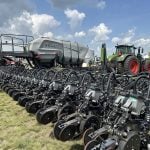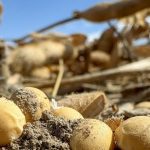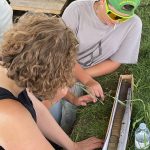Canada has seen a two million-acre decrease in forage land in the last five years.
“In over a decade, we are losing about three million acres, and they’re taken over by wheat and canola. It’s a serious concern for us,” Dr. Hari Poudel, forage and breeding research scientist at Agriculture and Agri-Food Canada’s (AAFC) Lethbridge Research and Development Centre, told the Canadian Forage and Grassland Association convention attendees.
“In general, there is only a three per cent increase in forage productivity per decade, compared to 15 per cent in wheat.”
- RELATED: Choosing forage varieties without getting lost in the weeds
- RELATED: ‘Drought proof’ your pasture with legumes
Poudel said forage breeding can increase overall biomass and economic gain, but cultivar development is a lengthy and costly process, spanning 12 to 15 years and costing $250,000 to $500,000 from breeding to commercialization. Compared to cash crops, forages are often grown on marginal land, receive fewer inputs and lack research funding.
Read Also

The Canadian Cattle Association’s international advocacy efforts
Global ag policies affect Canadian food policy, so the Canadian Cattle Association participates in international and domestic forums
Four dynamic forage breeding programs in Canada are researching more than 10 tame forage species. Alfalfa is common throughout the programs because it is grown nationally.
Poudel’s Lethbridge research includes alfalfa-cicer milkvetch compatibility studies, sainfoins grass compatibility and sainfoin diversity studies, drought-tolerant alfalfa and lipid improvement projects involving alfalfa and sainfoin using conventional versus CRISPR/cas9 gene editing methods.
“In all of the five breeding programs, we are doing drought-tolerant testing,” he said, including Lethbridge’s experimental LRC16-4656, a winter-hardy and grazing-tolerant alfalfa developed by crossing 300 plants selected from a 20-acre block of AC Blue J alfalfa grazed continually for seven years.
The LRC16-4656 Lethbridge trials have shown linear increases against AC Blue J and Beaver and higher yields in Foothills, Alta. However, the most intriguing results are from the 2018 seeded Creston, B.C. trial, where five years of data from 2019 to 2024, excluding 2020 due to COVID-19, were collected, said Poudel.
“From the second year, this cultivar (LRC16-4656) started taking over both of these (Blue J by 13 per cent and Beaver by 33 per cent) cultivars and consistently,” said Poudel. “I’m very excited about this one.”
Poudel’s sainfoin compatibility with grasses study spans five environments in Lethbridge, Alta., Saskatoon, Sask., and Carmen, Man., from 2018 to 2020, using five sainfoin cultivars: Mountainview, Glenview, LRC-3432, LRC-4498, and Melrose. Same-row and alternate-row seeding integrated the sainfoin into hybrid bromegrass, meadow bromegrass, and orchardgrass through same-row and alternate-row seeding.
Results indicate that meadow brome-grass showed the best biomass yield in all environments, while orchardgrass excelled in the sainfoin contribution trials.
“What I concluded is if you give a weight of 50-50 per cent for both the sainfoin per person and dry matter yield, you have to go with Mountainview mixed with orchardgrass for all the locations,” he explained. “But if you care less about sainfoin per person and more about the dry matter yield, then LRC-4498 mixed with meadow brome, that’s the best combination in all five locations.”
Quebec Research and Development Centre research scientist Dr. Annie Claessens is focused on improving the forage nutritive value, yield and persistence performance of alfalfa, timothy, switchgrass, tall fescue and orchardgrass to support superior beef and dairy animal performance and hay industry forages.
Her two alfalfa research objectives are to increase sugar content and select less dormant and more cold-tolerant traits to improve animal performance and productivity.
Claessens’s alfalfa NSC4 synthetic cultivar has shown a three to five percent sugar gain, a two to three per cent decrease in fibre and a one to three per cent increase in digestibility for dairy clusters II and III. In contrast, the alfalfa PD1 synthetic cultivar for beef clusters III and IV realized a 21 per cent higher dry matter total yield and a 70 per cent yield increase at the fourth cut with no significant difference in winter survival.
The timothy trials for higher summer regrowth and increased total yield for intermediate- (QF-2201) and late- (QF-2102) maturing varieties showed a 10 to 15 per cent increase against the check for a total dry matter yield of nine and 10 tonnes per hectare, respectively.
From 2025 to 2027, Claessens expects to launch alfalfa sugar content and timothy productivity field trials nationwide and eastern Canadian alfalfa productivity field trials.
AAFC’s Kentville Research and Development Centre researcher Dr. Yousef Papadopoulos is exploring the role of forage species and varieties, including red clover, birdsfoot trefoil and alfalfa with orchard-grass in modern cropping systems.
The objectives include enhancing forage productivity and resilience, developing pasture mixes and forage legumes for the long-term sustainability of ruminant production, and nutrient cycling.
His recently released AAC Trueman alfalfa cultivar has long-term persistence, including winter hardiness and tolerance for midsummer drought, spring and fall water-logging and frequent grazing.
During the three post-establishment harvest years, the new variety demonstrated yield superiority against AC Cariboo, the check cultivar, particularly in the second and third seasons.
Additionally, Papadopoulos’s new winter-hardy, acidic soil-tolerant TA08-1003 alfalfa cultivar and the winter-hardy, grazing-tolerant NO94-100 ochardgrass, which was highest yielding in the Atlantic Canada trials, were both supported for registration with a projected 2026 rollout.
















